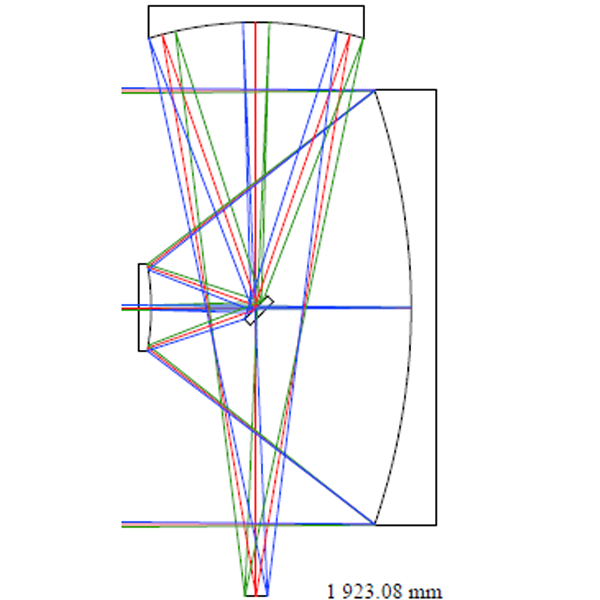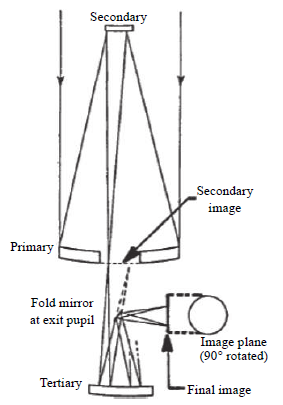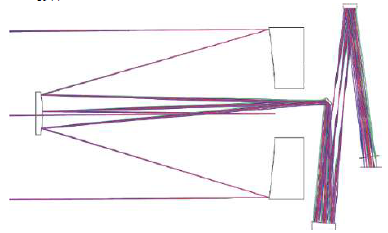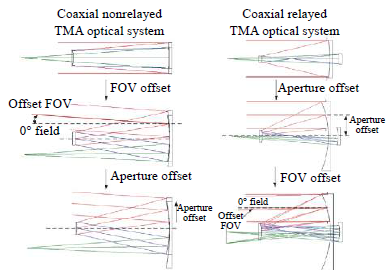Although many coaxial three-mirror reflective optical system designs have been proposed by optical designers, many of these designs are not practical due to aperture obstruction factors. In the 1970s, Korsch proposed several two-axis three-mirror reflective optical system designs that have significant practical value. These systems are all secondary imaging systems, featuring an intermediate image plane, as well as real entrance and exit pupils. Based on aberration analysis, the distribution of optical power and aspherical design of the three mirrors can eliminate third-order spherical aberration, coma, and astigmatism. In 1972, Korsch provided the solving equations for a three-mirror reflective optical system structure that can correct the first three primary aberrations and achieve a flat field. He also proposed a two-axis three-mirror reflective optical system structure.

In this system, the primary mirror and the secondary mirror form a focal point located between them, which is the system’s first image plane. By placing a 45° flat folding mirror at this first image plane, the light is reflected to the tertiary mirror, and then imaged onto the final image plane. This optical system can achieve comprehensive performance in terms of focal length, relative aperture, and field of view. Figure 7 shows an example of a Korsch two-axis three-mirror reflective optical system designed by the author. Under the design specifications of a focal length of 24 meters, a relative aperture of 1:3, and a field of view angle 2ω of 1°, it can still ensure near-diffraction-limited imaging.

In 1990, Sasian redesigned the 45° flat folding mirror in the Korsch two-axis three-mirror system as a concave mirror, forming a two-axis four-mirror system. In this design, the exit pupil of the optical system is located at the last concave mirror, allowing for the correction of optical system aberrations by placing an active mirror at the exit pupil. In 1977, Korsch proposed two other two-axis three-mirror reflective optical system structures. In the first structure, the primary mirror and the secondary mirror form a configuration similar to a Cassegrain system, creating a real image plane, or first image plane, just behind the primary mirror. The tertiary mirror then images the first image plane onto the final image plane with a magnification close to 1:1. To avoid having the image plane inside the optical system, as in the Paul Baker three-mirror system, a 45° flat folding mirror is placed between the back of the primary mirror and the tertiary mirror at the exit pupil position, directing the image plane outwards.

This system often uses an offset field of view and has the capability to achieve a linear field of view of around 2°. The optical structure can adjust the imaging magnification of the tertiary mirror according to the imaging and functional requirements, thereby obtaining different lengths of back focal distance. A typical application of this system is the optical system of the High Resolution Science Imaging Experiment (HiRISE) camera, which was launched in 2005 to explore Mars. The HiRISE optical system has a focal length of 12,000 mm, a relative aperture of 1:24, and a field of view angle of 1.142° × 0.175°.

The second structure proposed by Korsch is shown in Figure 10. In this structure, a 45° flat mirror is placed in the diagonal direction of the primary mirror and the tertiary mirror. The flat mirror has a central aperture, creating an annular field of view for the optical system. The exit pupil of the optical system is designed to be near the central aperture of the flat mirror to minimize the size of the aperture.

The Supernova/Acceleration Probe (SNAP) telescope adopted this structural form for the design of its optical system.
